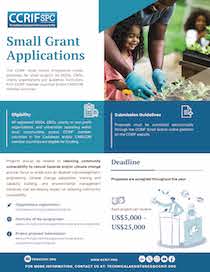Grand Cayman, 31 August, 2010 – The Caribbean Catastrophe Risk Insurance Facility (CCRIF) is preparing to make a payout to the Government of Anguilla as a result of Tropical Cyclone Earl which passed close to Anguilla and other islands in the northeastern Caribbean as a major hurricane yesterday.
Early reports indicate that Earl blew the roofs off of buildings and downed many power lines in Anguilla. Severe beach erosion and flooding have also impacted the island. Antigua & Barbuda and St Kitts & Nevis, both also covered by CCRIF policies, were less severely impacted, though some flooding and coastal damage has been reported.
Anguilla has both tropical cyclone and earthquake policies with CCRIF as part of the country’s disaster risk management strategy. The storm was of sufficient magnitude to trigger the hurricane coverage. Based on preliminary calculations undertaken using CCRIF’s catastrophe loss model and the most recent data from the National Hurricane Center, Anguilla will receive just over US$4M after 14 days, during which time a final calculation of loss and payout will be made.
CCRIF is working with regional partners, particularly the Caribbean Institute for Meteorology and Hydrology (CIMH), and local disaster management officials in Anguilla to collect on-the-ground information relevant to hazard and risk assessment. Beyond offering risk transfer options and making payouts to countries in the region, CCRIF is also engaged in supporting the collection of accurate post-impact information in order to better understand the challenges faced, and therefore inform its own and other regional response mechanisms.
CCRIF is hopeful that the rapid payment of funds under Anguilla’s policy will assist the Government and people of Anguilla in addressing immediate needs as they begin contemplating the rebuilding process. The Board and operational team at CCRIF wish the country a speedy recovery from the impacts of Earl.
About CCRIF: CCRIF is a risk pooling facility, owned, operated and registered in the Caribbean for Caribbean governments. It is designed to limit the financial impact of catastrophic hurricanes and earthquakes to Caribbean governments by quickly providing short term liquidity when a policy is triggered. It is the world’s first and, to date, only regional fund utilising parametric insurance, giving Caribbean governments the unique opportunity to purchase earthquake and hurricane catastrophe coverage with lowest-possible pricing. CCRIF represents a paradigm shift in the way governments treat risk, with Caribbean governments leading the way in pre-disaster planning.
CCRIF was developed through funding from the Japanese Government, and was capitalised through contributions to a multi-donor Trust Fund by the Government of Canada, the European Union, the World Bank, the governments of the UK and France, the Caribbean Development Bank and the governments of Ireland and Bermuda, as well as through membership fees paid by participating governments.
Sixteen governments are members of the fund: Anguilla, Antigua & Barbuda, Bahamas, Barbados, Belize, Bermuda, Cayman Islands, Dominica, Grenada, Haiti, Jamaica, St. Kitts & Nevis, St. Lucia, St. Vincent & the Grenadines, Trinidad & Tobago and the Turks and Caicos Islands..
For more information, contact Simon Young at syoung@caribrm.com / 202-465-4301 or CCRIF at pr@ccrif.org or visit the website at www.ccrif.org





